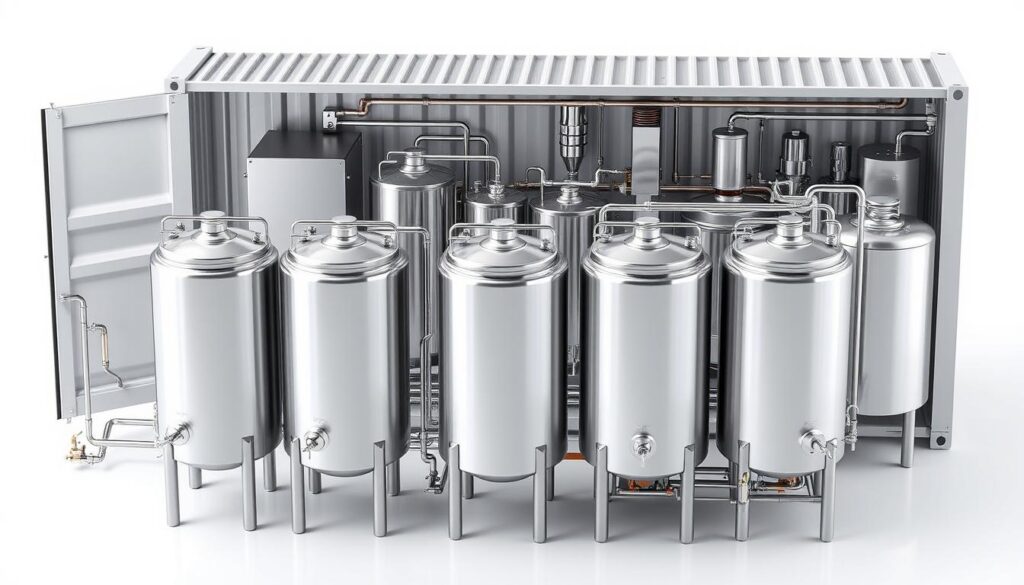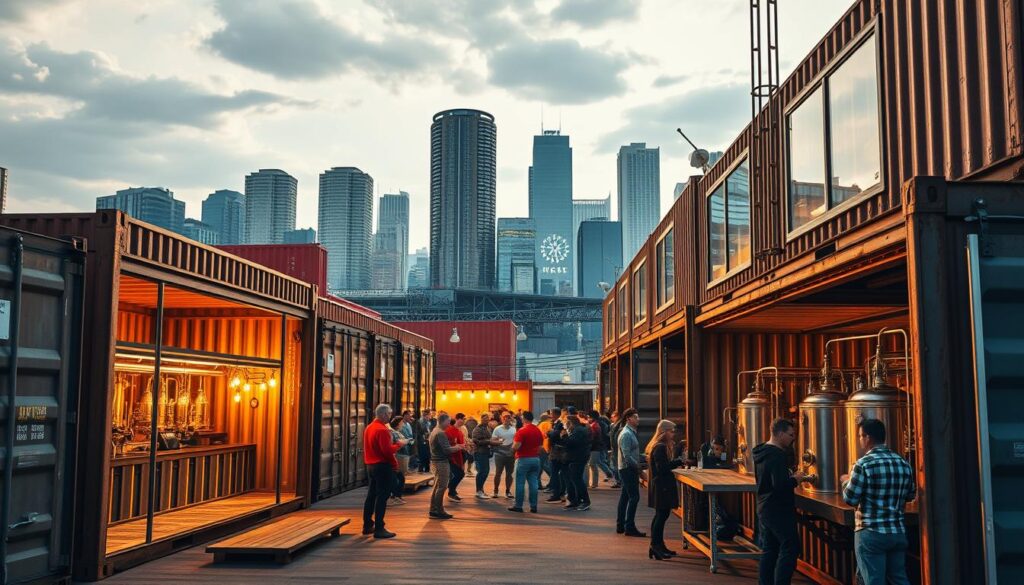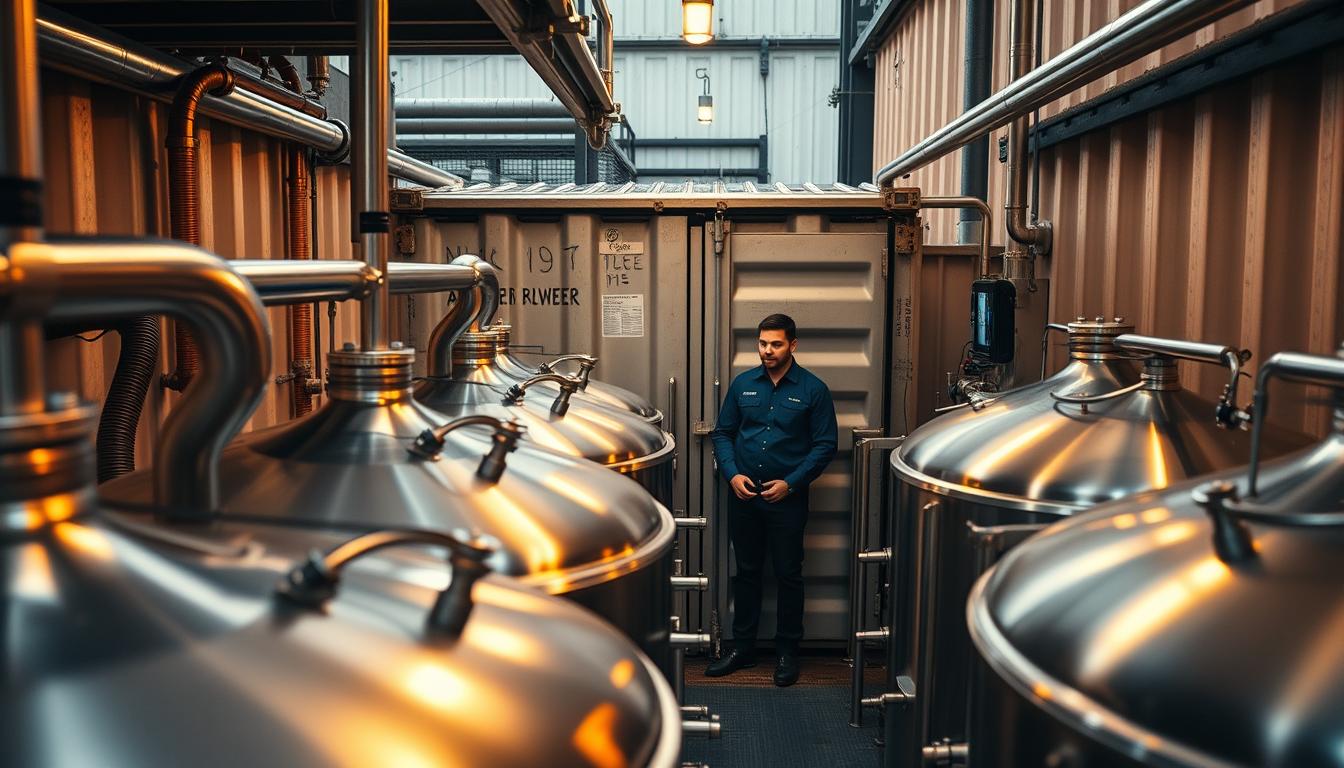Can a shipping container be transformed into a thriving brewery? The answer is a resounding yes, and it’s a trend that’s gaining momentum in the craft brewing industry. Container-based microbreweries are revolutionizing the way beer is produced, offering a unique blend of innovation, sustainability, and flavor.
Craft brewing in containers has become increasingly popular due to its flexibility and cost-effectiveness. These shipping container breweries can be set up almost anywhere, from urban centers to rural landscapes, making craft beer more accessible to a wider audience.
The rise of container-based microbreweries is a testament to the industry’s adaptability and creativity. As the craft brewing scene continues to evolve, it’s clear that these innovative breweries are here to stay.
Key Takeaways
- Container-based microbreweries offer a flexible and cost-effective way to produce craft beer.
- Shipping container breweries can be set up in various locations, increasing accessibility.
- The trend is driven by innovation, sustainability, and a passion for unique flavors.
- Craft brewing in containers is gaining popularity worldwide.
- These breweries are revolutionizing the craft brewing industry.
The Craft Beer Revolution in Portable Form
The craft beer revolution has taken a significant turn with the advent of container-based microbreweries. This innovative approach to brewing has brought together the worlds of craft beer and container architecture, creating a unique and exciting trend in the beverage industry.
The Convergence of Craft Beer and Container Architecture
The idea of brewing beer inside shipping containers may seem unconventional, but it’s a concept that’s gaining traction. By repurposing containers, brewers can create mobile brewing solutions that are both cost-effective and flexible. This convergence of craft beer and container architecture is opening up new possibilities for microbreweries.
Defining the Container Brewery Concept
A container brewery is essentially a microbrewery built inside a shipping container. These breweries are designed to be compact, efficient, and easily transportable. They offer a unique solution for brewers looking to start small or experiment with new recipes.
The American Craft Beer Landscape
The United States has a thriving craft beer scene, with thousands of microbreweries across the country. Container breweries are becoming an integral part of this landscape, offering a new and innovative way to produce portable beer production. As the craft beer industry continues to evolve, container breweries are likely to play a significant role in shaping its future.
Brewing in a Box: The Rise of Container-Based Microbreweries
The traditional brewing industry is being disrupted by the emergence of container-based brewing operations. This innovative approach to brewing has transformed the way craft beer is produced and consumed.
From Traditional Brewhouses to Shipping Containers
The shift from traditional brewhouses to shipping containers has been a significant development in the craft brewing industry. Container breweries offer a unique blend of mobility, flexibility, and cost-effectiveness that traditional breweries can’t match. By repurposing shipping containers, brewers can create compact, efficient brewing operations that can be easily relocated or expanded.
As noted by industry experts, “The use of shipping containers in brewing represents a bold step towards modern brewing methods.” This approach not only reduces startup costs but also allows for rapid deployment and scalability.
Key Milestones in Container Brewery Development
The development of container breweries has been marked by several key milestones. One of the earliest adopters was a brewery in the United States, which pioneered the concept in the early 2010s. Since then, the concept has gained popularity worldwide, with numerous breweries adopting innovative brewery technology to improve their operations.
How the Craft Beer Movement Embraced Mobility
The craft beer movement has always been about innovation and experimentation. The adoption of container breweries is a natural extension of this ethos, allowing brewers to be more agile and responsive to changing consumer preferences. As one brewer noted, “Container breweries have given us the freedom to experiment with new recipes and brewing techniques, while also being able to reach new markets.”
The rise of container-based microbreweries is a testament to the industry’s willingness to embrace new ideas and technologies. As the craft beer landscape continues to evolve, it’s likely that we’ll see even more innovative applications of container breweries and modern brewing methods.
Why Entrepreneurs Are Turning to Container Breweries
Container breweries are gaining popularity among entrepreneurs looking for a cost-effective entry into the craft beer market. This innovative brewing model offers a unique blend of flexibility, scalability, and reduced initial investment, making it an attractive option for new entrants in the industry.
Cost-Effectiveness Compared to Traditional Breweries
One of the primary reasons entrepreneurs are drawn to container breweries is their cost-effectiveness. Traditional breweries require significant upfront investments in infrastructure, including brewing equipment and facility renovations. In contrast, container breweries utilize existing shipping containers, significantly reducing initial costs.
Comparative Startup Costs:
| Category | Traditional Brewery | Container Brewery |
|---|---|---|
| Initial Investment | $500,000+ | $100,000 – $200,000 |
| Facility Costs | High | Low to Moderate |
| Equipment Costs | High | Moderate |
Reduced Time-to-Market Advantages
Container breweries also offer a reduced time-to-market compared to traditional breweries. Since they often utilize pre-existing containers and can be equipped with pre-installed brewing equipment, entrepreneurs can start brewing and selling their products much sooner.
Scalability and Expansion Opportunities
The scalability of container breweries is another significant advantage. Entrepreneurs can start with a single container and expand their operations as demand grows, adding more containers or moving to a larger facility if needed.
The Anatomy of a Container Brewery
The anatomy of a container brewery reveals a complex system designed for optimal brewing in a compact space. Container breweries are a testament to innovative brewery technology, combining efficiency with the ability to produce high-quality craft beer.
Essential Equipment and Space Optimization
A container brewery is equipped with specialized brewing equipment that is optimized for the limited space available. This includes compact brewhouses, fermentation tanks, and cooling systems, all designed to work efficiently within the container’s dimensions.

Production Capacity and Limitations
While container breweries offer flexibility, they also have limitations in terms of production capacity. The size of the container and the equipment installed dictate the maximum brew size. Typically, a standard 40-foot container can accommodate a brew system capable of producing between 500 to 1000 liters per batch.
Customization Options and Configurations
Container breweries can be customized to fit specific needs, including different layouts and equipment configurations. There are two main configurations:
- Single Container Solutions: Ideal for smaller operations or those just starting out, single container breweries contain all necessary equipment within one unit.
- Multi-Container Brewery Complexes: Larger operations or those looking to expand can opt for multi-container setups, where different containers house different parts of the brewing process, such as brewing, fermentation, and packaging.
Single Container Solutions
Single container solutions are perfect for portable beer production, allowing breweries to move their operation as needed. They are also more cost-effective, reducing initial investment costs.
Multi-Container Brewery Complexes
Multi-container complexes offer greater flexibility and scalability. They allow breweries to dedicate specific containers to different stages of the brewing process, potentially increasing overall production capacity and efficiency.
Technical Challenges and Innovative Solutions
Brewing in a box comes with its unique set of challenges, from climate control to plumbing issues. Despite these hurdles, container breweries are finding innovative ways to adapt and thrive.
Climate Control and Insulation Considerations
One of the primary technical challenges faced by container breweries is maintaining optimal brewing conditions within the container. Climate control and insulation are crucial to ensure consistent brewing results. Innovative solutions include:
- Advanced insulation materials to regulate temperature
- Climate-controlled fermentation chambers
- Smart temperature monitoring systems
Plumbing and Electrical Systems
Container breweries require efficient plumbing and electrical systems to support brewing operations. Challenges include:
- Designing plumbing systems that fit within the limited space
- Ensuring reliable electrical supply for brewing equipment
- Implementing safety measures to prevent electrical hazards
Brewing Process Adaptations for Limited Space
Adapting brewing processes to fit within the confines of a shipping container is a significant challenge. Innovative brewery technology has enabled breweries to:
- Optimize brewing equipment for compact spaces
- Implement efficient brewing cycles to maximize production
- Utilize modular brewing systems for scalability
By addressing these technical challenges with innovative solutions, container breweries can achieve high-quality brewing results while maintaining the flexibility and cost-effectiveness that make container brewing so appealing.
Financial Aspects of Container Brewing
As the popularity of container breweries continues to grow, understanding the financial implications becomes crucial for entrepreneurs. The initial investment for a container brewery can vary widely based on factors such as size, equipment, and location.
Startup Costs and Investment Requirements
Startup costs for container breweries typically include the purchase or lease of shipping containers, brewing equipment, and initial inventory. Cost-effective solutions and strategic planning can help minimize initial expenses. For instance, opting for used equipment or refurbished containers can significantly reduce startup costs.
Operational Expenses and Revenue Potential
Ongoing operational expenses include ingredients, utilities, marketing, and licensing fees. Container breweries can generate revenue through beer sales, events, and merchandise. Efficient operations and effective marketing strategies are crucial for maximizing revenue potential.
Funding Options for Container Brewery Entrepreneurs
Entrepreneurs can explore various funding options, including loans, grants, and investors. Crowdfunding and partnerships with established breweries or investors are also viable strategies.
Understanding these financial aspects is essential for the success of container brewery ventures. By carefully planning startup costs, managing operational expenses, and exploring funding options, entrepreneurs can navigate the financial challenges of container brewing.
Business Models for Container-Based Brewing
Container breweries are revolutionizing the craft beer industry with innovative business models. These modern brewing methods offer flexibility and creativity in how breweries operate and interact with their customers.
Pop-Up and Event-Based Operations
One of the most exciting aspects of container breweries is their ability to participate in pop-up events and festivals. This portable beer production capability allows breweries to reach new customers and create brand awareness without being tied to a single location.
For instance, breweries can attend beer festivals, collaborate with local businesses, or host their own events in different locations, maximizing their exposure.
Permanent Installations with Tasting Rooms
While mobility is a key advantage, many container breweries opt for permanent installations, complete with tasting rooms. This model allows for a more traditional brewery experience, where customers can visit and enjoy beers on tap.
A well-designed tasting room can become a community hub, fostering customer loyalty and providing a space for events and tastings.
Franchise and Expansion Strategies
Some entrepreneurs are exploring franchise models for container breweries, replicating successful operations in new locations. This strategy can help expand brand reach and create a network of container breweries.
| Business Model | Key Features | Benefits |
|---|---|---|
| Pop-Up and Event-Based | Mobile, festival participation | Brand exposure, flexibility |
| Permanent Installations | Tasting rooms, local presence | Customer loyalty, community building |
| Franchise and Expansion | Replicable model, brand scaling | Market penetration, network effects |
As the craft beer industry continues to evolve, container breweries are poised to play a significant role, offering diverse business models that cater to different markets and consumer preferences.
Success Stories: Pioneering Container Breweries in America
The story of container breweries in America is one of creativity, resilience, and a passion for craft brewing. As the craft beer industry continues to evolve, container breweries are at the forefront, offering innovative solutions to traditional brewing challenges.

Urban Container Brewery Case Studies
In urban areas, container breweries are thriving, bringing craft beer to the heart of communities. For instance, San Francisco’s Cellarmaker Brewing has successfully integrated a container brewery into its operations, expanding its production capacity while maintaining a small footprint.
Another example is Denver’s Great Divide Brewing Co., which has utilized container brewing to experiment with new recipes and beer styles, engaging with the local community through innovative events.
Rural and Destination Container Breweries
Rural and destination container breweries offer a unique experience, often becoming tourist attractions in their own right. Breweries in scenic locations are using containers to create immersive experiences, combining the love of nature with the love of craft beer.
For example, some breweries are located near national parks or along scenic trails, attracting visitors who are looking for both adventure and great beer.
Lessons from Established Container Brewing Operations
Established container breweries offer valuable insights into the challenges and opportunities of this brewing model. Key lessons include the importance of flexibility and adaptability, as well as the need for creative marketing and community engagement.
By studying these success stories, aspiring brewery owners can better navigate the complexities of container brewing, from regulatory hurdles to consumer expectations.
The Consumer Experience and Community Building
As container breweries continue to rise in popularity, the focus on consumer experience has become a key differentiator. Creating a positive and engaging experience for visitors is crucial for building a loyal customer base and fostering a sense of community.
Tasting Room Design in Limited Spaces
Effective tasting room design is essential, even in limited spaces. Container breweries can maximize their area by incorporating multi-functional elements, such as movable furniture and interactive features. This not only enhances the consumer experience but also encourages social media sharing.
Events and Community Engagement Strategies
Hosting events and engaging with the local community are vital strategies for container breweries. By organizing beer festivals, live music nights, and brewery tours, container breweries can attract a diverse crowd and build a loyal following.
Social Media and Digital Marketing for Container Breweries
In today’s digital age, a strong online presence is crucial. Container breweries can leverage social media platforms to share their story, promote events, and engage with customers. By utilizing modern brewing methods and innovative brewery technology, container breweries can create a compelling narrative that resonates with beer enthusiasts.
Navigating Regulations and Licensing in the US
To operate a successful container brewery, entrepreneurs must understand and comply with a myriad of regulations at the federal, state, and local levels. This complex regulatory landscape can be challenging, but with the right guidance, container breweries can thrive.
Federal Brewing Regulations for Mobile Operations
Container breweries must comply with federal regulations set by the Alcohol and Tobacco Tax and Trade Bureau (TTB). This includes obtaining the necessary permits and following guidelines for labeling, taxation, and production.
State and Local Permitting Variations
In addition to federal regulations, container breweries must navigate state and local permitting requirements, which can vary significantly. For example, some states require special permits for mobile brewing operations, while others have specific zoning laws that affect where a container brewery can be located.
Health Department and Safety Compliance
Container breweries must also comply with health department regulations and safety standards. This includes maintaining a clean and safe brewing environment, adhering to food safety guidelines, and ensuring that all employees are properly trained.
By understanding and complying with these regulations, container breweries can ensure a successful and sustainable operation. It’s crucial for entrepreneurs to stay informed and adapt to any changes in the regulatory landscape.
Conclusion: The Future of Container-Based Brewing
The rise of container-based microbreweries is revolutionizing the craft brewing industry, offering a unique blend of mobility, flexibility, and innovation. As the market for bag-in-box containers continues to grow, driven by increasing demand for beverages and sustainable packaging solutions, craft brewing in containers is poised for significant expansion.
Shipping container breweries are at the forefront of this trend, providing entrepreneurs with cost-effective, scalable, and adaptable solutions for brewing. With ongoing innovations and adaptations, the future of container-based brewing looks promising, offering new opportunities for breweries to reach consumers and build brand loyalty.
As the industry continues to evolve, it is clear that container-based brewing will play a significant role in shaping the future of craft beer, enabling breweries to brew, innovate, and connect with consumers in new and exciting ways.

